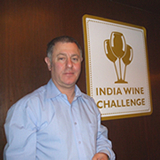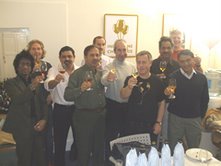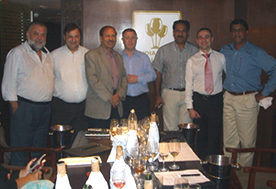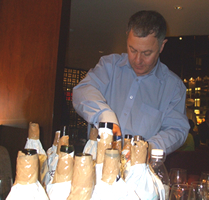|
 I
was naturally interested to read some of the comments about the first
India Wine challenge - of which I was chairman. I would like to deal with
all of the points that have been made. Firstly and unsurprisingly, I'd
like to respond to the accusation that the competition was "rigged".
I launched the UK International Wine Challenge in 1984 and oversaw its
growth to a current state of being the biggest wine competition in the
world, with over 9,000 wines. I have also run wine challenges in Japan,
China, Singapore, Hong Kong, Russia, Vietnam and Thailand and am chairman
of the Swiss Intl Wine Competition in South Africa and the Tri Nations
Cup in Australia. I
was naturally interested to read some of the comments about the first
India Wine challenge - of which I was chairman. I would like to deal with
all of the points that have been made. Firstly and unsurprisingly, I'd
like to respond to the accusation that the competition was "rigged".
I launched the UK International Wine Challenge in 1984 and oversaw its
growth to a current state of being the biggest wine competition in the
world, with over 9,000 wines. I have also run wine challenges in Japan,
China, Singapore, Hong Kong, Russia, Vietnam and Thailand and am chairman
of the Swiss Intl Wine Competition in South Africa and the Tri Nations
Cup in Australia.
In all of these over 50 competitions I have never been accused of "rigging"
a contest and resent the accusation here. The wines were tasted blind
in London and Delhi (at the Hyatt) by a panel of expert Indian and international
palates.
 |
| Judges in London |
These were Subhash Arora (London and Delhi); Ronnie Lobo (London); Abhay
Kewadkar (London and Delhi); Sourish Bhattacharya (Delhi); Alok Chandra
(Delhi); and from Europe, Stephane Soret, Sommelier of the Imperial, Delhi
(Delhi); Bill Marchetti (Delhi); Steve Daniel, former buyer for the Oddbins
wine chain in the UK (London); Cyrus Rustom Todiwala MBE Executive Chef,
Cafe Spice Namaste (London); Keith Isaacs Master of Wine (London); Bill
Rolfe former buyer of the UK Unwins wine chain (London). All of these
people will confirm the rectitude of the procedures adopted at every stage.
I would like to comment on many people expressing surprise at the poor
showing of Grover wines in this competition. I expected them to do better
myself. However, I carefully re-tasted the bottles following the competition
and concluded that they were not nearly as impressive as the ones I had
previously experienced in India and the UK.
It will be interesting to see whether the Grover Reserve (of the same
2005 vintage) fares better in other competitions.
This is an essential point. One of the reasons I run as many wine competitions
as I do is because I do not believe in the absolute validity of ANY individual
competition or encounter between a critic and a wine. As in the sporting
arena, consistency is all: the difference between Tiger Woods and the
flash in the pan golfer who wins a single tournament.
It was also interesting that the low marks given to the majority of the
Indian wines were given by a panel which was largely made up of Indian
judges.
 |
| Judges at the Hyatt, Delhi |
Some people feel the entry costs were high. The fee was $160, which compares
favourably to other international competitions. I believe one set of samples
was allowed free to those exhibiting at the IFE-India. It should be noted
that our costs included the flying to the UK and accommodation for three
Indian judges (Subhash Arora, Ronnie Lobo and Abhay Kewadkar as well as
the shipping from London (and the payment of customs duty and excise)
to Delhi of 200 samples for re-tasting and presentation.
We had reluctantly decided to run part of the competition in London,
with Indian judges because of the nightmarish costs due to the duties,
and difficulties of getting samples into India. If we can overcome this
next year I will be delighted.
Let me also clarify what the medals mean in numerical terms. The answer
is simple: wines with 18.5/20 or more get Gold; 17-18.4 get Silver; 15.5-16.9
get Bronze and 14-15.4 get a Seal of Approval. These criteria are in line
with the ones used in Australian and New Zealand competitions and the
International Wine Challenge and Decanter Awards, but are stricter than
those of some other competitions. In other words, a Seal of Approval here
might have won a Bronze elsewhere.
The Indian results in this competition (mostly No Awards and Seals of
Approval, with four Bronzes and sole Silver) were very much in line with
what I might have expected from previous tastings, but it was encouraging
to see new wineries enter the fray. As it was to see the quantum leap
in quality that has been made by Nine Hills between its (very poor) first
and second vintages, following, it should be said, visits by the Australian
chief winemaker of Pernod Ricard, Nine Hills's owners. ( In fact,
we confirmed it from Rukn Luthra- the project head of Nine Hills at Seagram's,
who said that Peter Hayes had visited India on more than a couple of occasions
to offer his expertise. Their white wines, though entered could not win
a medal- Editor)
 Quality
control remains a problem with Indian wines: one winery in particular
submitted several bottles of wine that were oxidised (prematurely aged)
indicating problems at the winemaking or storage or transport stages. Quality
control remains a problem with Indian wines: one winery in particular
submitted several bottles of wine that were oxidised (prematurely aged)
indicating problems at the winemaking or storage or transport stages.
I also believe that there is considerable work to be done in the vineyards
to improve the way the vines are being grown. Switching from growing grapes
for eating to winegrowing is not a straightforward process, and far too
many wines, in fact most of them show a "green" character belying
a lack of fundamental ripeness - even in the case of wines with significant
alcohol levels.
I wish the Indian wine industry well - as well as the Indian market for
good imported wines. And it is with this wish that I will begin work on
the 2008 India Wine Challenge. Any positive suggestions for what we can
do to further improve that event will be very welcome.
Robert Joseph
Chairman, India Wine Challenge
London
|